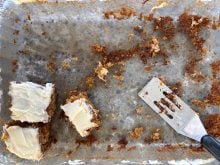Jodie, Barb, Betty Ann and I started writing this column six years ago,
on Jan. 1, 1996. How time flies. The first column was entitled “New
Columnists look forward to readers’ questions.” We continue to
encourage you to send them to TEAM Resources, c/o The Western Producer,
Box 2500, Saskatoon, Sask. S7K 2C4.
We were pleased with your response to the recipe/craft contest that we
offered before Christmas. Many wonderful ideas were sent in. We wish
all of you could have received the cookbook prize.
Read Also

VIDEO: Bittersweet harvest for this family farmhand
Bruce Burnett helps his brother harvest wheat and canola for the last time on the family farm in Manitoba where they both grew up.
Edible bowls
Dear TEAM: Could you print a recipe for bread bowls, like some
restaurants serve soup and stew in? Have you a recipe for low-fat
bread, either whole wheat or multi-grain? Juices on the store shelves
are really confusing. “Real orange juice, cranberry blend and others.”
Do they all have vitamin C? Or are they all artificial colour and
flavour and sugar? Recently someone pointed out to me that Cheese Whiz
has listed calcium chloride as an ingredient. Is that the same calcium
chloride that is used to keep tractor tires inflated? Why is it used? –
M.R., Preeceville, Sask.
Dear M.R.: Thanks for asking for a recipe for bread bowls. I have often
thought of making them but had not until now. The three bread recipes
are from Fleischmann’s Yeast.
Bread bowls
51/4-6 cups all-purpose 1.3-1.5 L
flour
2 tablespoons sugar 30 mL
41/2 teaspoons QuickRise 22mL
instant yeast (2 envelopes)
11/2 teaspoons salt 7 mL
1 cup water 250 mL
1 cup milk 250 mL
2 tablespoons butter 30 mL
or margarine
In a large bowl, combine two cups (500 mL) flour, sugar, undissolved
yeast and salt.
Heat water, milk and butter until very warm, 120-130 F (50-55 C).
Gradually add to dry ingredients. Beat two minutes at medium speed of
electric mixer, scraping bowl occasionally. Stir in enough remaining
flour to make a soft dough. Knead on lightly floured surface until
smooth and elastic, about 10 minutes. Cover and let rest for 10 minutes.
Divide dough into four equal portions; shape each into a ball. Place on
greased baking sheet. Cover; let rise in warm, draft-free place until
doubled in size, about one hour.
Bake at 375 F (190 C) for 20 to 25 minutes or until done. Remove from
baking sheets; cool on wire rack.
Cut off one-third of loaf and hollow out the loaf to form 1/4 inch (0.5
cm) thick bowl. Fill with soup.
I prefer to leave a thicker than 1/4 inch (0.5 cm) bowl and to eat some
of the bread in the bowl with the soup.
Low-fat breads
Regarding your request for low fat bread recipes, you could try
reducing the amount of fat in any of your favourite bread recipes by
using less butter or margarine, by substituting skim milk for whole
milk or by using egg whites instead of whole eggs. I tried reducing the
butter in the following recipes and the bread was just as tasty.
Most breads are not high in fat, as you can see by the nutritional
information given for the following recipes. In these recipes, each
slice will contain approximately 11/2 grams of fat.
Multigrain bread
1 cup water 250 mL
1 cup plain yogurt 250 mL
1/4 cup vegetable oil 50 mL
1/2 cup rolled oats 125 mL
(old-fashioned or quick)
1/3 cup wheat germ 75 mL
1/3 cup bran 75 mL
4-41/2 cups all-purpose 1-1.12 L
flour
1/4 cup firmly packed 50 mL
brown sugar
41/2 teaspoons 22 mL
QuickRise instant yeast
(2 envelopes)
13/4 teaspoons salt 8 mL
2 eggs
additional wheat germ or
oats, for topping
Heat water, yogurt and oil to simmering. Stir in oats, wheat germ and
bran. Set aside until cooled to very warm 120-130¡ F (50-55 C), about
30 minutes.
In large bowl, combine one cup (250 mL) flour, brown sugar, undissolved
yeast and salt. Add cooled bran mixture and blend well. Stir in one egg
and enough remaining flour to make soft dough. Knead on a lightly
floured surface until smooth and elastic, about seven minutes.
Cover and let rest on floured surface for 10 minutes.
Divide dough in half. Roll each half to 30 x 17.5 cm rectangle.
Beginning at short end of each, roll up tightly as for jellyroll. Pinch
seams and ends to seal. Place, seam sides down, in two greased 20 x 10
cm pans. Cover and let rise in warm, draft-free place until doubled in
size, about 30 to 45 minutes.
Lightly beat remaining egg and brush on the loaves. Sprinkle with wheat
germ or oats. Bake at 375 F (190 C) for 25 to 30 minutes or until done.
Remove from pans; let cool on wire racks.
Nutrition information per serving (1/24 of recipe): calories 147; total
fat 4 g; saturated fat 0 g; cholesterol 18 mg; sodium 182 mg; total
carbohydrate 24 g; dietary fibre 2 g; protein 5 g.
Whole wheat bread
8-81/2 cups whole 2-2.125 L
wheat flour
41/2 teaspoons 22 mL
traditional or QuickRise yeast (2 envelopes)
21/2 teaspoons salt 12 mL
11/2 cups water 375 mL
11/2 cups milk 375 mL
1/4 cup honey 50 mL
1/4 cup vegetable oil 50 mL
In large bowl, combine 31/2 cups (875 mL) flour, undissolved yeast and
salt. Heat water, milk, honey and oil until very warm 120-130 F (50-55
C). Gradually add to dry ingredients. Beat two minutes at medium speed
of electric mixer, scraping bowl occasionally. Add one cup (250 mL)
flour; beat two minutes at high speed, scraping bowl occasionally. With
spoon, stir in enough remaining flour to make soft dough. Knead on
lightly floured surface until smooth and elastic, about seven minutes.
Place in greased bowl, turning to grease top. Cover and let rise in
warm, draft-free place until doubled in size, about 45 to 60 minutes.
(With QuickRise yeast, cover kneaded dough and let rest on floured
surface for 10 minutes. Proceed with recipe.)
Punch dough down. Remove dough to lightly floured surface and divide
dough in half. Roll each half to a 30 x 17.5 cm rectangle. Beginning at
short end of each rectangle, roll up tightly as for jellyroll. Pinch
seams and ends to seal. Place, seam sides down, in two greased 20 x 10
cm loaf pans. Cover and let rise in warm, draft-free place until
doubled in size, about 30 to 60 minutes.
Bake at 375 F (190 C) for 35 to 45 minutes or until done. Remove from
pans; let cool on wire racks.
Nutrition information per serving (1/32 of recipe): calories 136; total
fat 3 g; saturated fat 0 g; cholesterol 1 mg; sodium 191 mg; total
carbohydrate 25 g; dietary fibre 4 g; protein 5 g. Makes two loaves.
For questions about baking or additional bread recipes with
Fleischmann’s Yeast, visit its website www.breadworld.com or call
800-777-4959.
Juices on the store shelf
Yes, you are right, there are a wide variety of juices on the store
shelves. The best way to tell what is in the juice is to read the
label. The ingredients are listed in descending order, with the most
plentiful ingredient first. Therefore the first two ingredients listed
are a good indication as to the makeup of the juice.
If the first two ingredients are water and sugar, then it contains
little or no real juice.
The amount of vitamin C, either natural or added, will be listed on the
label. Another guideline is that if it claims to be juice, then it
should be real fruit. If it is another name such as punch, cocktail,
beverage or drink, then it likely is not real fruit.
The University of California Berkeley Wellness Letter tells us there is
little or no nutritional difference between juice labelled “from
concentrate” and “not from concentrate.” Both are excellent sources of
vitamin C.
Calcium chloride
This chemical compound has a wide variety of uses in industry, in
agriculture and in foods. To answer your question regarding calcium
chloride, I called Kraft Canada. It said that in Cheese Whiz calcium
chloride is a firming agent and an acidity adjusting agent. It is a
food product approved for use by the Canadian government. It is also
often used in bread products.
SACDD
My friend Norma told me about SACDD, the Saskatchewan Action Committee
for Death with Dignity. It is a volunteer charitable organization
working to make all aware of the issues related to death with dignity.
It says each person has the right to decide what would make his/her
death dignified. In making that decision a person must consider legal,
medical, family and personal issues. SACDD has information to help with
that and can provide speakers and workshop leaders.
SACDD will help write advance health care directives, also called
living wills, so a person’s wishes can be recorded regarding whether to
remove his or her life support system when there is no reasonable
expectation of recovery. The directive does not apply if the individual
is able to speak for himself.
In most provinces, including Saskatchewan, a substitute decision-maker
can be named to speak when the individual cannot make or communicate
those wishes.
While SACDD is a Saskatchewan organization, it has members from other
provinces.
All provinces have recognized health care directives and see them as
important, but do not have similar organizations. The lifetime
membership fee is $10.
For more information, write to: SACDD, Box 23043, Saskatoon, Sask., S7J
5H3, 306-373-8696, fax 306-653-3822, e-mail sacdd@sk.sympatico.ca.
















